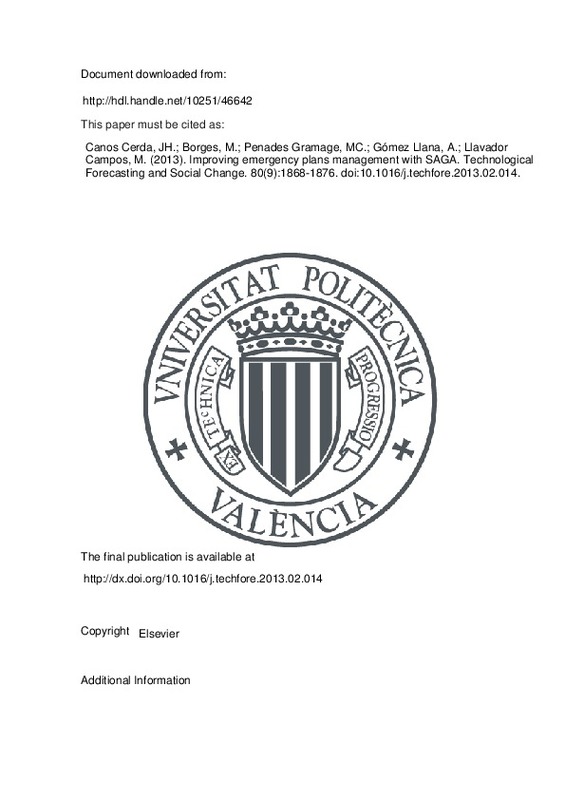JavaScript is disabled for your browser. Some features of this site may not work without it.
Buscar en RiuNet
Listar
Mi cuenta
Estadísticas
Ayuda RiuNet
Admin. UPV
Improving emergency plans management with SAGA
Mostrar el registro sencillo del ítem
Ficheros en el ítem
| dc.contributor.author | Canos Cerda, José Hilario
|
es_ES |
| dc.contributor.author | Borges, Marcos
|
es_ES |
| dc.contributor.author | Penadés Gramage, María Carmen
|
es_ES |
| dc.contributor.author | Gómez Llana, Abel
|
es_ES |
| dc.contributor.author | Llavador Campos, Manuel
|
es_ES |
| dc.date.accessioned | 2015-02-02T14:21:59Z | |
| dc.date.available | 2015-02-02T14:21:59Z | |
| dc.date.issued | 2013-11 | |
| dc.identifier.issn | 0040-1625 | |
| dc.identifier.uri | http://hdl.handle.net/10251/46642 | |
| dc.description.abstract | [EN] Emergency plans are the tangible result of the preparedness activities of the emergency management lifecycle. In many countries, public service organizations have the legal obligation to develop and maintain emergency plans covering all possible hazards relative to their areas of operation. However, little support is provided to planners in the development and use of plans. Often, advances in software technology have not been exploited, and plans remain as text documents whose accessibility is very limited. In this paper, we advocate for the definition and implementation of plan management processes as the first step to better produce and manage emergency plans. The main contribution of our work is to raise the need for IT-enabled planning environments, either at the national or organization-specific levels, which can lead to more uniform plans that are easier to evaluate and share, with support to stakeholders other than responders, among other advantages. To illustrate our proposal, we introduce SAGA, a framework that supports the full lifecycle of emergency plan management. SAGA provides all the actors involved in plan management with a number of tools to support all the stages of the plan lifecycle. We outline the architecture of the system, and show with a case study how planning processes can benefit from a system like SAGA. | es_ES |
| dc.description.sponsorship | We thank J. Marzal and R. Garrido, from the UPV Prevention Service, for their cooperation in the early design of SAGA. The work of J.H. Canós, M.C. Penadés, M. Llavador and A. Gómez is partially funded by the Spanish Ministerio de Educación y Ciencia (MEC) under grant TIPEx (TIN2010-19859-C03-03). The work of M.R.S. Borges is partially supported by grant nos. 560223/2010-2 and 308003/2011-0 from CNPq (Brazil) and grant no. E-26/103.076/2011 from FAPERJ (Brazil). The cooperation between the Brazilian and the Spanish research groups was partially sponsored by the CAPES/MECD Cooperation Program, Project #169/PHB2007-0064-PC. | |
| dc.language | Inglés | es_ES |
| dc.publisher | Elsevier | es_ES |
| dc.relation.ispartof | Technological Forecasting and Social Change | es_ES |
| dc.rights | Reserva de todos los derechos | es_ES |
| dc.subject | Emergency management | es_ES |
| dc.subject | Emergency plans development and improvement | es_ES |
| dc.subject | Information system | es_ES |
| dc.subject.classification | LENGUAJES Y SISTEMAS INFORMATICOS | es_ES |
| dc.title | Improving emergency plans management with SAGA | es_ES |
| dc.type | Artículo | es_ES |
| dc.identifier.doi | 10.1016/j.techfore.2013.02.014 | |
| dc.relation.projectID | info:eu-repo/grantAgreement/MICINN//TIN2010-19859-C03-03/ES/TECNOLOGIAS DE LA INFORMACION PARA LA PLANIFICACION Y EL ENTRENAMIENTO DE SITUACIONES DE EMERGENCIA/ | es_ES |
| dc.relation.projectID | info:eu-repo/grantAgreement/FAPERJ//E-26%2F103.076%2F2011/ | es_ES |
| dc.relation.projectID | info:eu-repo/grantAgreement/CNPq//560223%2F2010-2/ | es_ES |
| dc.relation.projectID | info:eu-repo/grantAgreement/CAPES//#169%2FPHB2007-0064-PC/ | es_ES |
| dc.relation.projectID | info:eu-repo/grantAgreement/CNPq//308003%2F2011-0/ | |
| dc.rights.accessRights | Abierto | es_ES |
| dc.contributor.affiliation | Universitat Politècnica de València. Departamento de Sistemas Informáticos y Computación - Departament de Sistemes Informàtics i Computació | es_ES |
| dc.description.bibliographicCitation | Canos Cerda, JH.; Borges, M.; Penadés Gramage, MC.; Gómez Llana, A.; Llavador Campos, M. (2013). Improving emergency plans management with SAGA. Technological Forecasting and Social Change. 80(9):1868-1876. https://doi.org/10.1016/j.techfore.2013.02.014 | es_ES |
| dc.description.accrualMethod | S | es_ES |
| dc.relation.publisherversion | http://dx.doi.org/10.1016/j.techfore.2013.02.014 | es_ES |
| dc.description.upvformatpinicio | 1868 | es_ES |
| dc.description.upvformatpfin | 1876 | es_ES |
| dc.type.version | info:eu-repo/semantics/publishedVersion | es_ES |
| dc.description.volume | 80 | es_ES |
| dc.description.issue | 9 | es_ES |
| dc.relation.senia | 256543 | |
| dc.contributor.funder | Ministerio de Educación y Ciencia | |
| dc.contributor.funder | Conselho Nacional de Desenvolvimento Científico e Tecnológico, Brasil | |
| dc.contributor.funder | Fundação Carlos Chagas Filho de Amparo à Pesquisa do Estado do Rio de Janeiro | |
| dc.contributor.funder | Coordenaçao de Aperfeiçoamento de Pessoal de Nível Superior, Brasil | |
| dc.contributor.funder | Ministerio de Educación, Cultura y Deporte |







![[Cerrado]](/themes/UPV/images/candado.png)

